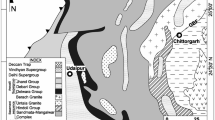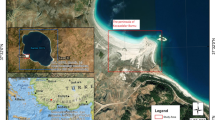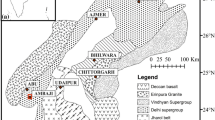Abstract
The earth crust is made up of variety of minerals. These minerals are having very significant applications in our day today life. The various studies, characterizing physical, chemical, electrical, structural properties, have been carried out on the Lonar crater for studying mineralogy, surface morphology and geology but has not been done by remote sensing technology. So, the proposed work focused on exploring the mineralogy at the Lonar crater by using high resolution hyperspectral imageries. The spectral reflectance of minerals was characterized by using FieldSpec4 spectroradiometer. The minerals at Lonar crater were explored by performing preprocessing and spectral analysis. The techniques used in the work are Spectral Angle Mapper and Spectral Feature Fitting. The results of the work marked the presence of pigeonite and augite at Lonar crater which indicates that this crater is the result of extrusive volcanic activity. Also, the presence of augite underneath basaltic igneous rocks as the rock type of Lonar crater. The salinity of the Lonar lake is proved by the presence of mirabilite and salt. Thus, the important results of this work are presence of minerals quartz, actinol, jarosite, pigeonite, augite, albite, mirabilite and scolecite. The significance of these minerals related to the crater is discussed here. It also validated the existence of these minerals which were identified through the previous geological, chemical, physical, electrical and magnetic studies and the minerals pyrite, chlorite, richter, illite, limonite, allanite, amphibolite and margarite were also identified.
Similar content being viewed by others
References
Danner, M.L., Hank, T. and Richter, K. (2015). Spectral Sampling with the ASD FieldSpec 4 — Theory, Measurement, Problems, Interpretation. EnMAP Field Guides Technical Report, GFZ Data Services.
Filho, A. P. (2000) Hyperspectral Remote Sensing For Mineral Mapping: A Case-Study At Alto Paraíso De Goías, Central Brazil. Jour. Geosci., v.30(3), pp.551–554.
Fredriksson, K.N., Noonan, A. and Nelen, J. (1973) Meteoritic, lunar and Lonar impact chondrules. The Moon, v.7(3–4), pp.475–482.
Goliber, S.W. (2019). Geologic Mapping of Both Alteration Mineralogies and Shock Stages of Ejecta Lobes at Lonar Crater, India using GPS, Lab Sample Analyses, and High Resolution Imagery. pp.1–2.
Goodenough, G.D. et al. (2003) Preprocessing Hyperion and ALI for forest classification. IEEE Trans. Geosci. Remote Sensing, v.41(6–1), pp.1321–1331.
Jarecke, P. Y. (2000) Radiometric calibration of the Hyperion imaging spectrometer instrument from primary standards to end-to-end calibration. Proc. Optical Sci. Tech. Symp., Earth Observ. Systems, v.1435, pp.1–9.
Khan, J. (2013). Preliminary Results — Hyperspectral Image Analysis for Dolomite Identification in Tarbela Dam Region of Pakistan. International Jour. Innovative Tech. Explor. Engg., (IJITEE), v.2(3), pp.1–6.
King, H.M. (n.d.) Basalt. Retrieved 03-09-2020, from https://geology.com/rocks: https://geology.com/rocks/basalt.shtml
Kruse, F.B. (2003) Comparison of airborne hyperspectral data and EO-1 Hyperion for mineral mapping. IEEE Aerospace Conference Proceeding, IEEE Trans. Geosci. Remote Sensing, v.41(6), pp.1388–1400.
Maloof A. C., Sarah T. Stewart, Benjamin P. Weiss, et al. (2010). Geology of Lonar Crater, India. Geol. Soc. Amer. Bull., v.122, pp.109–126.
Nevin Koshy, S.U. (2018) Characterization of the Soil Samples from the Lonar Crater, India. Geotech. Engg. Jour SEAGS & AGSSEA, v.49, pp.99–105.
Rajesh, H. M. (2004). Application of Remote Sensing and GIS in Mineral Resource Mapping- An Overview. Jour. Mineral. Petrolog. Sci., v.99, pp.83–103.
Yarakkula, M. V. (2017). Nontronite mineral identification in Nilgiri hills of Tamil Nadu using hyperspectral remote sensing. IOP Conf. Ser.: Mater. Sci. Eng., v.263, pp.1–13.
Acknowledgment
This work is supported by Department of Science and Technology, Government of India under the Funds for Infrastructure under Science and Technology (DST-FIST) with the sanction no. SR/FST/ETI340/2013 for the Department of Computer Science and Information Technology, Dr. Babasaheb Ambedkar Marathwada University, Aurangabad, Maharashtra, India. The authors are thankful of Department and University authorities for providing the support and infrastructure for carrying out this research.
Author information
Authors and Affiliations
Corresponding author
Rights and permissions
About this article
Cite this article
Gore, R., Mishra, A. & Deshmukh, R. Exploring the Mineralogy at Lonar Crater with Hyperspectral Remote Sensing. J Geol Soc India 97, 261–266 (2021). https://doi.org/10.1007/s12594-021-1676-4
Received:
Accepted:
Published:
Issue Date:
DOI: https://doi.org/10.1007/s12594-021-1676-4




